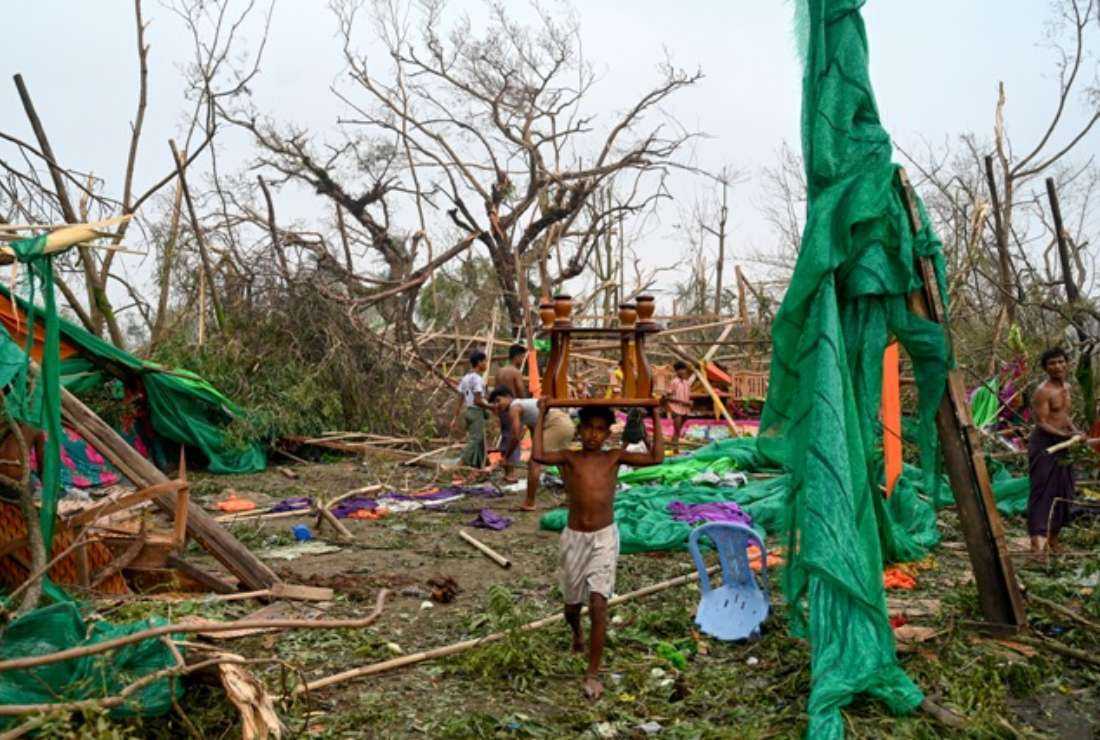
A child carries furniture at the Khaung Dote Khar Rohingya refugee camp on May 15 after cyclone Mocha made landfall between Cox's Bazar in Bangladesh and Myanmar's Sittwe carrying winds of up to 195 kilometers (120 miles) per hour, the biggest storm to hit the Bay of Bengal in more than a decade. (Photo: AFP)
Church groups and international agencies have rushed relief materials to cyclone-hit Bangladesh which is struggling to limp back to normalcy.
Bangladesh’s disaster management and relief ministry said 13,000 houses have been damaged, mostly in the southeastern Cox’s Bazar district after the cyclone hit the South Asian country, packed with 215 kph wind. The authorities had evacuated over 4,00,000 people to shelter camps before the storm hit around noon on May 14.
Papal charity Caritas Bangladesh has dispatched a team to take stock of the situation to rebuild the damaged houses.
“We are participating in a coordinated relief and rehabilitation work, led by the government,” Marcel Ratan Guda, who leads the activities of Caritas Bangladesh in the Chattogram region, said.
On the hard-hit Saint Martin’s island, a tiny coral island of only eight square kilometers, located about 10 kilometers south of mainland Bangladesh’s southeastern tip called Teknaf, normal life has come to a grinding halt.
The island, home to about 10,000 people, saw about 80 percent of its houses damaged in the cyclone that produced wind above 100 kph for about six hours.
“The Bay of Bengal is still rough, hampering communication with Saint Martin’s island,” said Guda.
About 700 houses were destroyed in the wind, leaving no trace behind, said Mujibur Rahman, chairman of Saint Martin’s Union Parishad, the smallest local government unit in Bangladesh.
Rahman put the overall number of damaged houses at over 1,000.
Many of its inhabitants do not have a place to return to after their houses of plastic and bamboo were blown away in minutes in the storm.
“The storm tore apart the life that I built bit by bit over the years,” said Zakir Hossain, 35, a father of three daughters, in a video call from the island.
“I have to start rebuilding literally from scratch,” said Hossain, who is a three-wheeler rickshaw-van puller and a resident of Konapara village.
Saint Martin Island lies in ruins at a time the rainy season is just around the corner. Tourists skip the island during the rainy season, which officially starts on June 1.
“It seems the rebuilding will have to be on hold for a long time,” added Hossain.
“I need at least 70,000 taka (US$ 649.16) for repairing my house,’ said Abu Tayeb, 61, a neighbor of Hossain.
Tayeb had to spend 1,000 taka for buying plastic to erect a roof over the head of his family of six, including his four unmarried daughters.
"I don’t think this roof will withstand the heavy monsoon rains,” said Tayeb, seeking help from god.
Tayeb, who used to teach at an Islamic seminary, lost his job years ago and does not have a specific source of income. Sometimes he is hired to pray for the dead.
The damaged houses included 1,300 houses belonging to Rohingya refugees living in the sprawling camps of Cox’s Bazar.
“These are not real houses. These were shanties,” said Mizanur Rahman, refugee relief and repatriation commissioner.
“These houses will soon be rebuilt,” he said.
Imran Hossain Sajib, chief executive officer of upazila, an administrative division under the district of Cox’s Bazar, said that they informed the government about the partial and complete destruction of 3,027 houses so far.
Normal life in the country is affected due to a shortage of liquefied natural gas from floating terminals in the Bay of Bengal. Full restoration of the terminals might take at least two weeks.
An acute gas crisis has gripped the country, leading to massive power shortages in vital places like Chittagong Medical College Hospital. The state-owned hospital is now depending solely on cylindered gas for cooking three meals for 3,157 patients.
Bangladesh Red Crescent Society has allocated 30 million taka for the cyclone-affected communities and decided to raise an emergency fund of 80 million taka soon.
‘Our volunteers are out on the ground assessing loss and damages,” a press statement quoted Sanjeev Kumar Kafley, head of the International Federation of Red Cross and Red Crescent Societies, as saying.
As homes and key facilities were destroyed, immediate priorities include the provision of emergency shelter, clean drinking water, food supplies and ensuring access to health and sanitation facilities, said the statement.
The United Nations has sought international help to address the dire situation due to the devastating impacts of Cyclone Mocha in Bangladesh.


